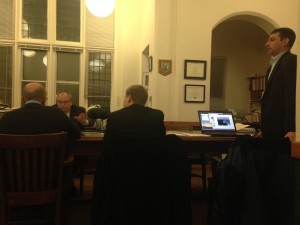During a special meeting held specifically to address the EPA’s draft NPDES permit, the Marion Board of Selectmen on February 5 were joined by consultant engineers from CDM Smith who schooled the selectmen on the history of the Town’s wastewater treatment plant, the EPA’s new stringent requirements, and a tentative $20 million encumbrance for the Town.
The deadline for comments in response to the draft NPDES permit, which stands for Nation Pollution Discharge Elimination System, was the next day, leaving only 24 hours to challenge the draft permit and try to persuade the EPA to reconsider its strict new nitrogen, heavy metal, and other pollutant levels on the Town’s wastewater treatment plant.
CDM Smith Project Manager Shawn Syde told selectmen that this draft permit is so different than the last one issued that, even with the latest in wastewater technology, the new requirements would be impossible to reach.
“It’s very aggressive,” said Syde, “and in our mind, unrealistic.”
The most significant, and most costly, change is the EPA’s elimination of unlined lagoon use and the prohibiting of allowing the biosolids (sludge) to degrade naturally in the lagoons.
Marion’s three unlined lagoons off Benson Brook Road were built in the 1970s and are integral to the function of the wastewater treatment plant. The lagoons store untreated excess wastewater and treats activated sludge, which then biodegrades on its own.
The draft permit would require the Town to have the sludge removed from the site for disposal.
According to the data the EPA used to draft the NPDES permit, the lagoons are leeching into the groundwater and polluting Aucoot Cove and Sippican Harbor with nitrogen and other heavy metals, to which Syde said there is no proof.
“Where we find ourselves right now is not because of something the Town of Marion has failed to do,” said Selectman Stephen Cushing. “…They changed the rules on us.”
As part of its response, the Town will challenge the data the EPA used and allege that the EPA was too rigid in its requirements, essentially putting an undue financial burden on the Town by not allowing it to seek alternative methods to comply with the new pollutant levels.
Capital costs to the Town that could exceed $20 million would include sludge treatment and disposal, the lining of the lagoons, the expanded filtration and monitoring of nitrogen, phosphorus, and other pollutants, and groundwater cleanup.
“I’ve never seen anything like this,” said CDM Smith Vice President and expert on estuary science Bernadette Kolb via speakerphone during the meeting.
The permit mandates a wastewater treatment plant upgrade as a solution to meet the new limits, which the CDM Smith representatives, Town Administrator Paul Dawson, and selectmen found unfair, since other alternatives exist that could meet the permit requirements.
Some alternatives, said Syde, would be to cease using the effluent brook that delivers treated water into Aucoot Cove and instead run a pipe along the brook.
Kolb said the Town could also create an outfall farther offshore to lessen the nitrogen impact the EPA says the wastewater treatment plant is causing along the shore. With that, said Kolb, there would be no need for nitrogen or phosphorus limits in the permit.
“So there is some room for some give and take in this,” said Chairman Jonathan Henry. Dawson told him, though, that the matter could go a number of ways.
“We don’t have any guarantee at this point that there will be any [give and take],” said Dawson.
The EPA could grant the permit as-is, it could withdraw the draft permit and allow the Town to explore other options, “or it could go in between,” said Dawson.
Dawson said the Town’s response “ought to give the EPA pause to think.”
After discussion, selectmen joked about renaming the unnamed ‘effluent brook’ to “Cushing’s Creek,” eliciting laughter. Dawson then suggested “Dawson’s Creek,” which won them over.
By Jean Perry
